SpaceX launched 60 new satellites into orbit today (Nov. 11). Weather permitting, you just might be able to see the spacecraft swarm soar overhead in your night sky tonight. Of course, you'll need to know where to look.
The new Starlink satellites are the second batch to join SpaceX's growing broadband internet constellation in orbit. They follow the May launch of 60 other satellites that surprised observers with how bright they appeared in the night sky. The night after their launch, those first Starlink satellites appeared as a brilliant string of pearls in the night sky.
"Due to the date and time of launch, conditions for visibility are not so good for Northwest Europe, where I am, nor indeed for the US, as they were in May." Netherlands-based satellite tracker Marco Langbroek, who captured video of the Starlink train in the sky, told Space.com in an email today. That's because the new Starlink satellites have only a few days of evening passes over Europe and the U.S. before shifting into daylight for the near future, he added.
Still, Langbroek added: "Because they seem to aim for a lower operational orbital altitude (350 km) than the previous 60 did (those were inserted at 440 km, so already 100 km higher than what this new batch of 60 aims for, and eventually were brought to 550 km), I expect these new objects to stay relatively bright, i.e. naked eye objects."
So, the new satellites launched today could be visible like their May counterparts for at least the next few nights. So, how to see them?
Video: Watch SpaceX Launch 60 New Starlink Satellites Into Orbit!
The key for any satellite tracker is to know when and where to look. Fortunately, there are several websites that offer forecasts to help amateur observers identify which direction to look and when for any area.
The tracking site Heavens-Above.com here already has a Starlink Launch 2 page ready. You can visit this Starlink page on the site to see the orbit of the new satellites. The direct link to the Starlink Launch 2 visible passes forecast is here, but don't forget to update the "location" tag in the upper right of the page to get your specific visibility forecast.
The next site to try is N2Y0.com, which automatically picks up your coordinates from your browser to show when and where particular bright satellites (and yes, the International Space Station, too) will be visible.
Another useful site is CalSky here. CalSky asks you to enter the satellite you're looking to spot (either by name or official number, if you know it). You can simply type "Starlink" and click "Go!" to find your personal forecast under "Sightings Opportunities" for each satellite.
This view of SpaceX's first Starlink satellites in orbit was captured in May 2019 by Netherlands-based satellite tracker Marco Langbroek.
(Image credit: copyright Marco Langbroek via SatTrackBlog)
"For prospective observers, I would advise to see whether Calsky of Heavens-Above issue predictions for your location, and allow for several minutes uncertainty in the pass time," Langbroek said. "I expect them to be bright now they are still very low, but having binoculars handy would be a good idea. Make sure your eyes are dark adapted (i.e. spent some 125 minutes in the dark at least, avoiding lamplight)."
The "train" view seen in May will likely only be visible over the next two nights, Langbroek said. So, you'll want to be sure to act fast. By the time the satellites are again visible at night, they'll be spread out in their final orbits and less of a sight, Langobroek added.
SpaceX launched the new Starlink satellites into a preliminary orbit of 174 miles (280 kilometers), but each of the 60 satellites is equipped with an ion engine to slowly raise its orbit to an altitude of about 217 miles (350 km).
Not everyone is as thrilled to see SpaceX's Starlink fleet in the night sky as Langbroek was in May, when he called the sight "spectacular."
Astronomers have complained that the bright satellites could endanger scientific observations of the night sky, especially since SpaceX plans to launch at least 12,000 Starlink satellites for its megaconstellation and is eyeing adding another 30,000 satellites in the future. With other companies like Amazon, OneWeb and Telesat planning their own megaconstellations, even Langbroek has concerns.
"I do have concerns about these mega-constellations in low earth orbit. One is
what it will do to our night sky - on a clear summer night, there is always one
or several satellite (s) visible almost at any given moment already," Langbroek said. "With so many to be added over a short time span of only a few years, it will drastically alter how we experience our night sky: the old character of the night sky will basically be lost."

SpaceX launched 60 Starlink satellites into orbit on its most flown Falcon 9 rocket yet, which made its fourth launch and landing, on Nov. 11, 2019.
(Image credit: SpaceX)
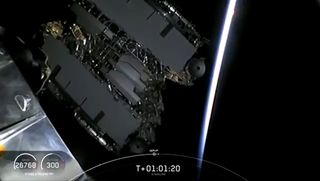
A view of SpaceX's 60 Starlink satellites being deployed all at once after a successful launch into orbit on Nov. 11, 2019.
(Image credit: SpaceX)
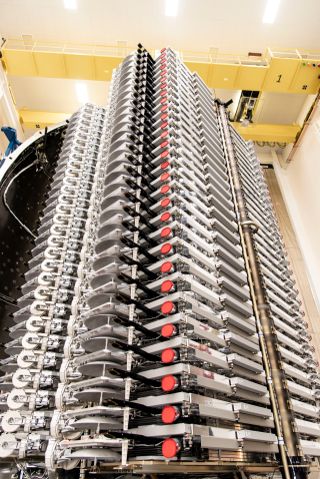
This SpaceX image shows the 60 Starlink satellites before their Nov. 11, 2019 launch.
(Image credit: SpaceX)
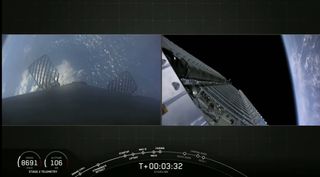
SpaceX's 60 Starlink satellites launched on Nov. 11 can be seen in the right camera view in this image after their payload fairing has deployed.
(Image credit: SpaceX)
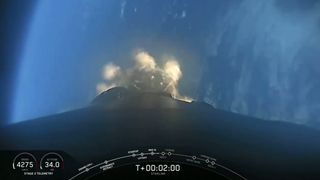
A view looking down at the Falcon 9 first stage during SpaceX's second Starlink launch.
(Image credit: SpaceX)
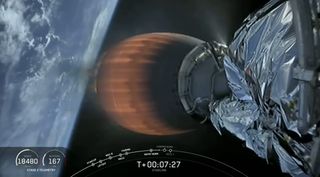
A view of the Falcon 9 second stage engine carrying SpaceX's new Starlink satellites to their initial orbit.
(Image credit: SpaceX)

SpaceX's Falcon 9 first stage, which launched on its fourth mission for Starlink's flight, nears its landing drone ship.
(Image credit: SpaceX)
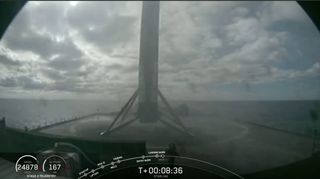
A view of the Falcon 9 rocket after a fourth successful landing.
(Image credit: SpaceX)
SpaceX CEO Elon Musk has said the company is looking into reducing the brightness of the satellites. Musk and other SpaceX representatives also stress that Starlink satellites are designed for a mission life of between one and 5 years.
At the end of a Starlink satellite's mission, the satellite is designed to use its ion engine to deorbit itself and burn up in Earth's atmosphere to avoid posing a space debris threat to other spacecraft, SpaceX has said.
Editor's note: An earlier version of this story incorrectly stated the orbit intended for this Starlink launch. It is 217 miles (350 kilometers), not 341 miles (550 km).
Email Tariq Malik at tmalik@space.com or follow him @tariqjmalik. Follow us on Twitter @Spacedotcom and on Facebook.

Need more space?
(Image credit: All About Space)
Science - Latest - Google News
November 12, 2019 at 04:59AM
https://ift.tt/34RSQ6I
How to Spot SpaceX's 60 New Starlink Satellites in the Night Sky - Space.com
Science - Latest - Google News
https://ift.tt/2Kb7H4e
Shoes Man Tutorial
Pos News Update
Meme Update
Korean Entertainment News
Japan News Update
Bagikan Berita Ini















0 Response to "How to Spot SpaceX's 60 New Starlink Satellites in the Night Sky - Space.com"
Post a Comment